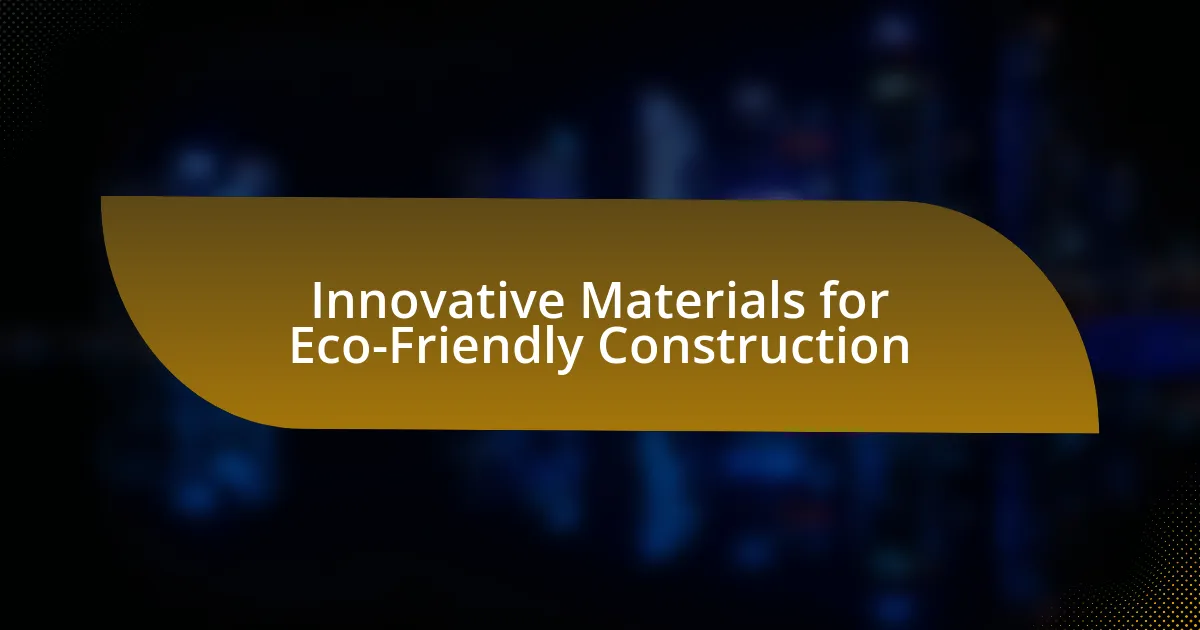Innovative materials for eco-friendly construction encompass a range of sustainable options, including bamboo, recycled steel, rammed earth, and mycelium-based composites. These materials contribute to sustainability by reducing resource consumption, enhancing energy efficiency, and minimizing environmental impact through lower carbon emissions. Key properties of eco-friendly materials include biodegradability, low toxicity, and energy efficiency, which collectively support healthier indoor environments and improved occupant well-being. The article also explores the challenges faced in promoting these materials, their financial benefits, and emerging trends in construction technology, such as 3D printing and smart materials, that further enhance sustainability in building practices.

What are Innovative Materials for Eco-Friendly Construction?
Innovative materials for eco-friendly construction include bamboo, recycled steel, rammed earth, and mycelium-based composites. Bamboo is a rapidly renewable resource known for its strength and flexibility, making it an excellent alternative to traditional timber. Recycled steel reduces the need for new metal production, which is energy-intensive, and can be reused multiple times without losing quality. Rammed earth utilizes natural soil to create durable walls with excellent thermal mass, minimizing energy consumption for heating and cooling. Mycelium-based composites, derived from fungi, offer biodegradable options for insulation and structural components, significantly lowering environmental impact. These materials collectively contribute to sustainable building practices by reducing waste, conserving resources, and minimizing carbon footprints.
How do these materials contribute to sustainability?
Innovative materials for eco-friendly construction contribute to sustainability by reducing environmental impact through lower resource consumption and enhanced energy efficiency. For instance, materials like recycled steel and bamboo require less energy to produce compared to traditional materials, leading to a decrease in greenhouse gas emissions. Additionally, the use of sustainable materials such as hempcrete and rammed earth not only sequesters carbon but also promotes better indoor air quality, which is essential for occupant health. Studies indicate that buildings constructed with these materials can achieve significant energy savings, with some demonstrating up to 50% reduction in energy use over their lifecycle.
What specific properties make these materials eco-friendly?
Eco-friendly materials possess specific properties that contribute to sustainability and environmental protection. These properties include biodegradability, which allows materials to decompose naturally without harming ecosystems; low toxicity, ensuring that they do not release harmful chemicals into the environment; and energy efficiency, which refers to the reduced energy consumption during production and use. Additionally, many eco-friendly materials are sourced from renewable resources, such as bamboo or recycled materials, which minimizes resource depletion. For instance, according to the U.S. Environmental Protection Agency, using recycled materials can significantly reduce energy usage and greenhouse gas emissions compared to using virgin materials.
How do innovative materials reduce environmental impact?
Innovative materials reduce environmental impact by utilizing sustainable resources and enhancing energy efficiency in construction. For example, materials like recycled steel and bamboo require less energy to produce compared to traditional materials, significantly lowering carbon emissions. Additionally, innovations such as self-healing concrete and insulation made from recycled plastics improve the longevity and thermal performance of buildings, further decreasing energy consumption over time. Studies indicate that using these materials can reduce the overall carbon footprint of construction projects by up to 30%, demonstrating their effectiveness in promoting eco-friendly practices.
What types of innovative materials are commonly used?
Innovative materials commonly used in eco-friendly construction include bamboo, recycled steel, rammed earth, and mycelium-based composites. Bamboo is favored for its rapid growth and strength, making it a sustainable alternative to traditional timber. Recycled steel reduces waste and energy consumption in production, while rammed earth utilizes natural soil to create durable structures with minimal environmental impact. Mycelium-based composites, derived from fungi, offer biodegradable options for insulation and packaging. These materials contribute to sustainable building practices by minimizing resource depletion and reducing carbon footprints.
What are the characteristics of recycled materials in construction?
Recycled materials in construction are characterized by their sustainability, cost-effectiveness, and versatility. These materials, derived from previously used products, significantly reduce waste and the demand for new raw materials, thereby minimizing environmental impact. For instance, using recycled concrete aggregates can lower construction costs by up to 30% compared to traditional materials, as reported by the National Ready Mixed Concrete Association. Additionally, recycled materials often possess comparable structural properties to virgin materials, ensuring they meet safety and performance standards. This combination of sustainability, economic benefits, and functional equivalence makes recycled materials a vital component in eco-friendly construction practices.
How do bio-based materials differ from traditional materials?
Bio-based materials differ from traditional materials primarily in their origin and sustainability. Bio-based materials are derived from renewable biological resources, such as plants and agricultural waste, while traditional materials often come from non-renewable sources like fossil fuels. For instance, bio-based plastics can be made from corn starch or sugarcane, which reduces reliance on petroleum-based products. This shift not only lowers carbon emissions during production but also promotes a circular economy by utilizing waste materials. Studies have shown that using bio-based materials can significantly reduce the environmental impact of construction, making them a more sustainable choice compared to conventional materials.
Why is the adoption of innovative materials important in construction?
The adoption of innovative materials is important in construction because it enhances sustainability, improves energy efficiency, and reduces environmental impact. Innovative materials, such as recycled plastics and bio-based composites, contribute to lower carbon footprints and resource conservation. For instance, using recycled materials can reduce waste sent to landfills by up to 90%, as reported by the Environmental Protection Agency. Additionally, materials like cross-laminated timber can sequester carbon, further mitigating climate change effects. Therefore, the integration of these materials not only meets modern construction demands but also aligns with global sustainability goals.
What role do these materials play in reducing carbon footprints?
Innovative materials for eco-friendly construction significantly reduce carbon footprints by minimizing greenhouse gas emissions during production and use. For instance, materials like recycled steel and bamboo require less energy to produce compared to traditional materials like concrete and virgin timber, leading to lower carbon emissions. Additionally, the use of insulating materials, such as cellulose or sheep’s wool, enhances energy efficiency in buildings, which reduces the demand for heating and cooling, further decreasing overall carbon emissions. Studies indicate that using sustainable materials can cut construction-related emissions by up to 30%, demonstrating their critical role in mitigating climate change impacts.
How can innovative materials enhance energy efficiency in buildings?
Innovative materials enhance energy efficiency in buildings by improving insulation, reducing energy consumption, and utilizing renewable resources. For instance, materials like aerogels and phase change materials provide superior thermal insulation, minimizing heat loss in winter and heat gain in summer. This leads to a reduction in heating and cooling energy requirements, which can decrease overall energy consumption by up to 30% according to the U.S. Department of Energy. Additionally, materials such as solar panels and green roofs harness renewable energy and improve building performance, further contributing to energy efficiency.
How can builders and architects integrate these materials into their projects?
Builders and architects can integrate innovative materials for eco-friendly construction by selecting sustainable options such as recycled steel, bamboo, and rammed earth. These materials can be incorporated into structural frameworks, insulation, and finishes, enhancing energy efficiency and reducing environmental impact. For example, using bamboo as a structural element can provide strength comparable to steel while being renewable and lightweight. Additionally, implementing recycled steel can significantly lower carbon emissions associated with new steel production, as it requires less energy to process. Studies indicate that buildings utilizing these materials can achieve up to 30% lower energy consumption compared to traditional construction methods, demonstrating their effectiveness in promoting sustainability.
What challenges do innovators face in promoting eco-friendly materials?
Innovators face significant challenges in promoting eco-friendly materials, primarily due to high production costs and limited consumer awareness. The production of eco-friendly materials often requires advanced technologies and sustainable sourcing, which can increase costs compared to conventional materials. For instance, a study by the National Institute of Standards and Technology found that biobased materials can be up to 20% more expensive than traditional options. Additionally, consumer awareness and demand for eco-friendly products remain low, as many consumers prioritize cost and convenience over sustainability. This lack of awareness can hinder market penetration and adoption of innovative materials, making it difficult for innovators to achieve widespread acceptance and scale their solutions effectively.

What are the benefits of using Innovative Materials for Eco-Friendly Construction?
The benefits of using innovative materials for eco-friendly construction include reduced environmental impact, improved energy efficiency, and enhanced durability. Innovative materials, such as recycled steel, bamboo, and hempcrete, minimize resource depletion and waste generation, contributing to sustainable building practices. For instance, using recycled materials can reduce carbon emissions by up to 70% compared to traditional materials, as reported by the U.S. Environmental Protection Agency. Additionally, these materials often provide better insulation and thermal performance, leading to lower energy consumption for heating and cooling. Enhanced durability also means longer lifespans for structures, which further decreases the need for frequent repairs and replacements, aligning with sustainable development goals.
How do these materials impact construction costs?
Innovative materials for eco-friendly construction can significantly reduce construction costs by enhancing energy efficiency and minimizing waste. For instance, materials like recycled steel and bamboo are often cheaper than traditional materials due to lower production costs and reduced transportation expenses. Additionally, using sustainable materials can lead to long-term savings through decreased energy consumption; buildings constructed with high-performance insulation can save up to 30% on heating and cooling costs, according to the U.S. Department of Energy. Furthermore, eco-friendly materials often qualify for tax incentives and rebates, further lowering overall expenses.
What are the long-term financial benefits of using eco-friendly materials?
The long-term financial benefits of using eco-friendly materials include reduced operational costs, increased property value, and potential tax incentives. Eco-friendly materials often lead to lower energy consumption, which can decrease utility bills significantly; for instance, buildings constructed with energy-efficient materials can save up to 30% on energy costs annually. Additionally, properties built with sustainable materials tend to have higher resale values, as buyers increasingly prioritize environmental sustainability. Furthermore, many governments offer tax credits or deductions for using eco-friendly materials, which can further enhance financial savings. These factors collectively contribute to a more favorable long-term financial outlook for projects utilizing eco-friendly materials.
How can innovative materials lead to reduced maintenance costs?
Innovative materials can lead to reduced maintenance costs by enhancing durability and minimizing the need for repairs. For instance, materials such as fiber-reinforced polymers and self-healing concrete exhibit superior resistance to environmental stressors, which significantly extends their lifespan. Research indicates that structures utilizing these materials can experience maintenance cost reductions of up to 30% over their lifecycle due to decreased frequency of repairs and replacements. This durability translates into lower labor and material expenses, making innovative materials a cost-effective choice for eco-friendly construction.
What health benefits do eco-friendly materials provide?
Eco-friendly materials provide significant health benefits by reducing exposure to harmful chemicals and improving indoor air quality. These materials, such as low-VOC paints, natural insulation, and sustainably sourced wood, minimize the release of toxic substances that can lead to respiratory issues, allergies, and other health problems. For instance, a study published in the Journal of Environmental Health found that using low-VOC materials can decrease indoor air pollutants by up to 50%, thereby enhancing overall well-being. Additionally, eco-friendly materials often promote better thermal regulation and moisture control, which can further contribute to a healthier living environment.
How do these materials improve indoor air quality?
Innovative materials for eco-friendly construction improve indoor air quality by reducing the presence of volatile organic compounds (VOCs) and enhancing air circulation. These materials, such as low-VOC paints, natural insulation, and non-toxic adhesives, emit fewer harmful chemicals, which directly contributes to a healthier indoor environment. For instance, studies have shown that using low-VOC materials can decrease indoor air pollution levels by up to 50%, significantly lowering the risk of respiratory issues and other health problems associated with poor air quality. Additionally, materials designed for better air circulation, like breathable wall systems, help to regulate humidity and prevent mold growth, further enhancing indoor air quality.
What are the implications for occupant health and well-being?
Innovative materials for eco-friendly construction significantly enhance occupant health and well-being by improving indoor air quality and reducing exposure to harmful substances. For instance, materials such as low-VOC paints and natural insulation reduce the presence of volatile organic compounds, which are linked to respiratory issues and other health problems. Studies indicate that buildings constructed with sustainable materials can lead to a 20% improvement in indoor air quality, thereby promoting better respiratory health among occupants. Additionally, the use of non-toxic materials contributes to a healthier living environment, which is associated with lower stress levels and improved mental well-being.
How do innovative materials influence building design and aesthetics?
Innovative materials significantly influence building design and aesthetics by enabling new architectural forms and enhancing sustainability. For instance, materials like cross-laminated timber and recycled composites allow for lighter structures with complex geometries, which can create visually striking designs while reducing the carbon footprint. Additionally, smart materials, such as photochromic or thermochromic surfaces, adapt to environmental changes, enhancing both functionality and visual appeal. Research indicates that the use of innovative materials can lead to a 30% reduction in energy consumption in buildings, demonstrating their impact on both design and environmental efficiency.
What design opportunities do eco-friendly materials present?
Eco-friendly materials present design opportunities that enhance sustainability, aesthetic appeal, and functionality in construction. These materials, such as bamboo, recycled metals, and reclaimed wood, allow architects and designers to create structures that minimize environmental impact while maximizing energy efficiency. For instance, using bamboo, which grows rapidly and absorbs carbon dioxide, can lead to buildings that are both strong and sustainable. Additionally, the incorporation of recycled materials can reduce waste and lower the carbon footprint of construction projects. Studies indicate that buildings designed with eco-friendly materials can achieve up to 30% energy savings compared to traditional materials, demonstrating their effectiveness in promoting sustainable design.
How can innovative materials enhance the visual appeal of structures?
Innovative materials enhance the visual appeal of structures by introducing unique textures, colors, and forms that traditional materials cannot achieve. For instance, materials like self-healing concrete and translucent wood not only serve functional purposes but also create striking visual effects that attract attention. Research indicates that the use of advanced composites and smart materials can lead to dynamic facades that change appearance based on environmental conditions, further enhancing aesthetic value. Additionally, the integration of sustainable materials, such as recycled glass and bamboo, contributes to a modern aesthetic while promoting eco-friendliness, aligning with contemporary architectural trends.

What are the future trends in Innovative Materials for Eco-Friendly Construction?
Future trends in innovative materials for eco-friendly construction include the increased use of bio-based materials, recycled content, and smart materials that enhance energy efficiency. Bio-based materials, such as mycelium and bamboo, are gaining traction due to their sustainability and low carbon footprint. Recycled materials, including reclaimed wood and recycled plastics, are being integrated into building designs to reduce waste and resource consumption. Additionally, smart materials, which can adapt to environmental changes, are being developed to optimize energy use and improve indoor air quality. These trends are supported by a growing emphasis on sustainable building practices and regulatory frameworks promoting green construction, as evidenced by the rise in LEED-certified projects and the global push for net-zero buildings.
How is technology shaping the development of new materials?
Technology is significantly shaping the development of new materials by enabling advanced manufacturing techniques and enhancing material properties. For instance, the use of 3D printing technology allows for the creation of complex geometries and customized materials that were previously impossible to achieve, leading to innovations such as bio-based composites and recycled materials. Additionally, advancements in nanotechnology improve the strength and durability of materials while reducing their environmental impact, as seen in the development of self-healing concrete that incorporates nanomaterials to repair cracks autonomously. These technological advancements not only facilitate the creation of eco-friendly construction materials but also promote sustainability by minimizing waste and energy consumption in the production process.
What role do advancements in nanotechnology play in eco-friendly materials?
Advancements in nanotechnology significantly enhance the development of eco-friendly materials by improving their properties and functionalities. Nanotechnology enables the creation of materials with superior strength, durability, and lightweight characteristics, which can reduce resource consumption and waste in construction. For instance, nanomaterials such as carbon nanotubes and nanoclays have been shown to improve the mechanical properties of concrete, leading to less material usage while maintaining structural integrity. Additionally, nanotechnology facilitates the incorporation of self-cleaning and antimicrobial properties into materials, reducing the need for chemical cleaners and enhancing sustainability. Research indicates that the use of nanotechnology in materials can lead to a reduction in energy consumption during production and a decrease in the overall environmental impact of construction projects.
How are 3D printing and prefabrication influencing material innovation?
3D printing and prefabrication are significantly influencing material innovation by enabling the development of customized, sustainable materials that reduce waste and enhance efficiency in construction. These technologies allow for the precise layering of materials, which can lead to the use of alternative, eco-friendly substances such as bioplastics and recycled composites. For instance, a study by the Massachusetts Institute of Technology found that 3D printing can reduce material waste by up to 90% compared to traditional construction methods. Additionally, prefabrication techniques streamline the construction process, allowing for the integration of advanced materials that improve energy efficiency and reduce the carbon footprint of buildings.
What are the emerging materials to watch in the construction industry?
Emerging materials to watch in the construction industry include cross-laminated timber (CLT), recycled concrete, and bio-based composites. Cross-laminated timber is gaining attention for its strength and sustainability, as it utilizes renewable wood sources and sequesters carbon. Recycled concrete, made from repurposed concrete waste, reduces landfill use and conserves natural resources, aligning with circular economy principles. Bio-based composites, which combine natural fibers with resins, offer lightweight and durable alternatives to traditional materials, promoting eco-friendliness. These materials are supported by industry trends emphasizing sustainability and resource efficiency, as highlighted in reports from the World Green Building Council.
What potential do mycelium and hempcrete hold for future construction?
Mycelium and hempcrete hold significant potential for future construction due to their sustainability, insulation properties, and carbon sequestration capabilities. Mycelium, the root structure of fungi, can be cultivated rapidly and used as a biodegradable building material, offering a renewable alternative to traditional materials. Studies indicate that mycelium composites can outperform conventional insulation materials in terms of thermal performance and fire resistance. Hempcrete, made from hemp fibers and lime, provides excellent insulation and is carbon-negative, meaning it absorbs more CO2 during its growth than is emitted during its production. Research shows that hempcrete can reduce energy consumption in buildings by up to 50% compared to standard materials. Together, these materials contribute to eco-friendly construction practices, aligning with global efforts to reduce carbon footprints and promote sustainable building solutions.
How are smart materials being integrated into eco-friendly building practices?
Smart materials are being integrated into eco-friendly building practices through their ability to adapt to environmental changes, enhance energy efficiency, and reduce waste. These materials, such as phase change materials, self-healing concrete, and responsive insulation, contribute to sustainable construction by optimizing energy use and extending the lifespan of structures. For instance, phase change materials can store and release thermal energy, thereby reducing heating and cooling demands, which is crucial in minimizing energy consumption in buildings. Additionally, self-healing concrete can repair its own cracks, leading to lower maintenance costs and reduced material waste over time. The incorporation of these smart materials aligns with the goals of green building certifications, such as LEED, which emphasize sustainability and resource efficiency in construction practices.
What best practices should builders follow when selecting innovative materials?
Builders should prioritize sustainability, performance, and cost-effectiveness when selecting innovative materials. Sustainable materials, such as recycled or rapidly renewable resources, reduce environmental impact and promote eco-friendly construction practices. Performance criteria, including durability, energy efficiency, and maintenance requirements, ensure that materials meet the demands of modern building standards. Cost-effectiveness involves evaluating the long-term savings associated with energy efficiency and reduced maintenance, which can offset initial material costs. Research indicates that using sustainable materials can lead to a 20% reduction in energy consumption over the lifecycle of a building, supporting the case for eco-friendly construction.
